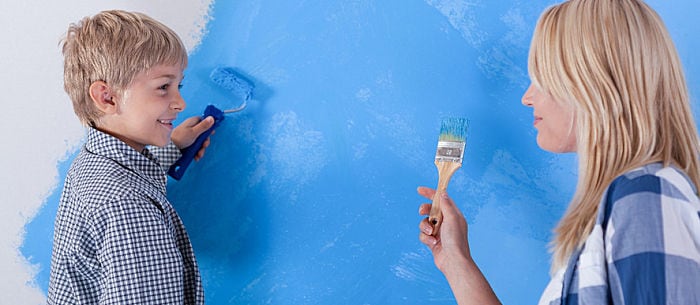Smell that? Paint is a versatile and affordable decorating option, but it has a downside — its chemical scent. But there’s good news: If you’re using low-VOC paint on your walls during your next redecorating project, you won’t smell it as much. The fumes are caused by VOCs, or volatile organic compounds, which can trigger serious health reactions in those who inhale them.
“VOCs consist of organic chemicals containing hydrogen and carbon that evaporate easily,” said Lisa Beres, a green home expert and the co-author of “Just Green It! Simple Swaps to Save the Planet and Your Health.” “This is where the term ‘off-gassing’ originates, and can also be attributed to that new home smell.”
According to the Environmental Protection Agency, paints with a high VOC content can cause a variety of medical issues including eye irritation, nose and throat irritation, headaches, loss of coordination and nausea. They may even damage your liver, kidneys and central nervous system. Some of these compounds are also known to cause cancer in humans.
Over the last few years, the paint industry has responded to the VOC hazard by introducing low- and no-VOC paints. “Purchasing low-VOC or zero-VOC paint should be non-negotiable for the health of your family and the environment,” says Beres.
“Traditional paint standards are set at 250 grams per liter (g/l) of VOCs for flat paints and 380 g/l for nonflat. Low-VOC paints and primers contain less than 50 g/l for both flat and nonflat sheens. Paints and primers that contain less than 5 g/l of VOCs are classified as zero-VOC. This is the same for primers.”
While low-VOC paint has healthier benefits, they are a bit pricier and possibly more time-consuming to apply. “VOCs serve a binding purpose so the main issue with low- and no-VOC paint is that you’ll need more coats,” says Ari Meisel, a green real estate developer and the author of “Less Doing, More Living.” “Sometimes you will need as many as seven additional coats, so labor costs can be a lot more expensive.” Keep that in mind while shopping for paint.
Safer For Mommy-to-Be
One of the chores on the top of the to-do list for a mommy-to-be is painting the nursery, so it’s important to know that low-VOC paint is definitely safer for pregnant women as well as children or anyone with a compromised immune system. “VOCs are linked to respiratory illnesses and memory impairment,” says Beres. Even if you use low-VOC paint, however, “proper precautions should always be taken in these higher-risk scenarios since paint consists of many other chemicals.”
To be safe, make sure to ventilate the room when you are painting. “Open windows and use an air purifier with a carbon or carbon zeolite component — or equivalent — to absorb gases and odors when painting, and continue to run it after for any off-gassing that can occur,” says Beres.
Before You Start Painting
Low-VOC paint can be found at most hardware and home improvement stores, and it’s not used any differently than traditional paint. “Always stick with the manufacturer’s instructions and use a primer for optimal results,” says Beres. If you are unsure what brand of paint is low-VOC, look for brands that have received certification from Green Seal or the Greenguard Environmental Institute.
Paints marked with the Greenguard Indoor Air Quality Certified logo have been tested to make sure that they contain low amounts of VOCs and, most importantly, are also low-emitting once applied.
“If you are reluctant to choose low-VOC paints due to their past poor reputation, then you’ll be happy to know that new low- and zero-VOC paints and coatings have been reformulated to improve performance,” says Beres. Before painting an entire wall, she suggests doing a patch test. “Most specialty brands offer small sample jars for a fraction of the cost,” she says. “Order a sample size first to be sure you like the sheen, coverage and color before committing to an entire room. Also, stick with flat and light colors as these tend to have lower VOC levels than gloss and deep, rich colors.”
Although low- and no-VOC paints are a bit pricier, preventing the potential hazards and damage to your indoor air quality that comes with traditional paint is well worth the cost.
Want more ways to reduce the use of chemicals in your home? Try these 9 Eco-Friendly Products.
Lisa Iannucci is a freelance writer who has written for many regional and national publications and has written more than 10 books, including “The Complete Idiot’s Guide to Green Building and Remodeling.”


